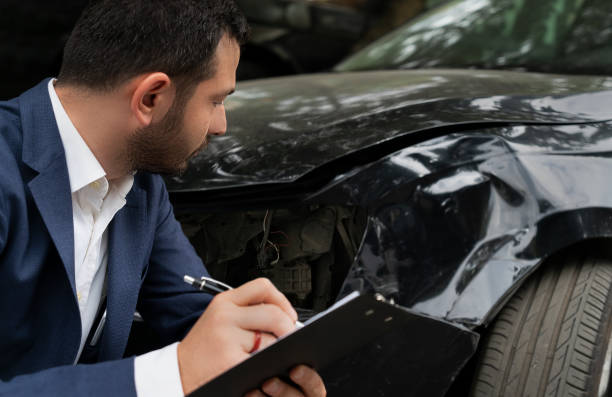When you get injured in a car crash that you didn’t cause, you’re entitled to seek compensation to cover things like medical expenses, car repairs, and lost wages.
But figuring out how to do this on your own can be tricky and that’s where a car accident lawyer comes in. A lawyer will help you navigate the complex legal process so you can get a fair car accident settlement.

What is a Car Accident Settlement?
Settlements often benefit both parties by saving them time, money, and effort. Simply put, it is an agreement between you and the negligent party or their insurance provider. The majority of car accident cases are resolved through settlement negotiations and only a tiny percentage of car accident cases go to trial. Parties tend to settle before going to court because a jury trial doesn’t always guarantee a favorable outcome.
Car Insurance Laws
All states except New Hampshire require drivers to carry car insurance. The car accident settlement process is determined by two types of car accident liability systems:
At-Fault System
Most states follow the traditional fault-based system. In this system the person at fault for the accident is responsible for the damages. Here are your options if you’re able to prove the other driver was at fault:
File a claim with your own insurance company
File a claim with the at-fault driver’s insurance company
File a lawsuit against the at-fault driver
No-Fault System
If your state follows the no-fault system (Florida, Hawaii, New Jersey, Michigan and a few others) you cannot sue the other driver (and vice versa). However, you can collect economic damages (e.g., property damage, lost wages, lost of earning capacity) regardless of who caused the accident.
Understanding the Car Accident Settlement Process
With an insurance claim, you can recover damages for:
Loss of income
Medical expenses
Repairs
Pain and suffering damages
The settlement process starts with gathering all the information and evidence you need – such as medical records, car repair receipts, photos of the damages and witness testimony – to support your claim.
After you’ve obtained all these things, you’ll need to draft a demand letter explaining your injuries and expenses attributed to the accident. After receiving your demand letter, your insurance company (or the other driver’s) will investigate your case. If accepted, they will then make a settlement offer.
This is where the negotiation begins. After you send the demand letter, the insurance company will hand over your case to a claims adjuster whose job is to find loopholes and employ tactics so that you get the smallest payout possible.

Negotiating can be compared to haggling at a yard sale. You might exchange offers and counteroffers a few times (the insurance adjuster wants to give you the lowest possible amount while you want to get the highest possible compensation) until you find common ground.
Important Considerations When Dealing with Car Accident Settlements
It’s crucial to understand the ins and outs of car accident settlements so you can make sure you get paid for all your losses.
1. Statutes of Limitations
Every state has time limits for filing injury claims. Often referred to as statutes of limitations, these laws decide how much time you have to take legal action after a car accident.
These laws exist so that claims can be resolved promptly. It would not be fair for someone to always worry about getting sued because of things that happened many years ago. There are exceptions for criminal cases such as murder–but these aren’t applicable to tort claims.
Aside from ensuring timely resolutions and fairness, statutes of limitations also ascertain (to a degree) that claims can be decided in a fair manner. The longer you wait, the more evidence is lost. Witnesses may also lose some details of what happened making it difficult to prove the plaintiff’s claims (or for a defendant to sufficiently defend themselves).
Depending on where you are and if the other driver was a government worker, you might have anywhere from less than a year to six years to sue for car accident damages.
The clock starts ticking right after the crash. Once that time limit passes, you can’t sue for damages from the other driver’s insurance.
2. Maximum Medical Improvement (MMI)
Before making a final offer, reaching MMI is usually needed as this ensures your damages are calculated properly so you’re not left with unexpected medical bills later on.
Maximum medical improvement (MMI) is when your medical condition stabilizes and won’t likely get better with more treatment. The MMI helps figure out how badly you’re hurt and what your future medical care might cost in order to determine the settlement amount.
At this point, your doctor can give a clear idea of what to expect, helping your lawyer figure out the amount you should get for your injuries.
Once MMI is set, your lawyer can add up all your medical bills from the accident – the amount you already paid and what you might pay in the coming days, weeks or months.
3. Witness Statements
Sometimes, the circumstances surrounding a car accident aren’t so clear and the other party might resist admitting fault. That’s where witness statements become invaluable.
Witnesses offer an impartial account of the incident which helps to bolster your case and challenge the other party’s narrative. They validate your injuries and debunk false claims. Just make sure your witness statements help boost credibility instead of hurt it.
How Much is the Car Accident Settlement Amount?
Since every case is different there’s no equation for the settlement amount. Your compensation will depend on various factors such as:
Insurance coverage
Motorist coverage
Severity of the injury
Property damage
Severity of the accident
Medical treatment
Long-term effects
The number of people involved
Percentage of fault in the accident
And a lot more.
Settlement Timeline
The timeframe for a personal injury claim varies widely, influenced by things like case complexity and willingness to settle. It could take a few weeks to several years.
If the insurer won’t budge, mediation is the next step. A neutral mediator helps both sides reach an agreement. If mediation fails, filing a lawsuit might be necessary, though it’s a significant decision that comes with major costs.
Once you’re able to negotiate a fair settlement that both parties agree to, the insurance company will then write a check to your lawyer, who deducts their fee before giving you the remainder. Now if your case goes to trial, payment hinges on the at-fault driver’s insurance coverage and financial capability.

The waiting game can be frustrating, but if you have an experienced car accident lawyer at your side, trust that they’re working hard to build a strong case for you.
Explore common car accident FAQs: insurance claims, legal rights, and safety tips to navigate post-collision situations effectively.